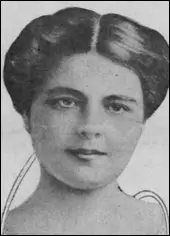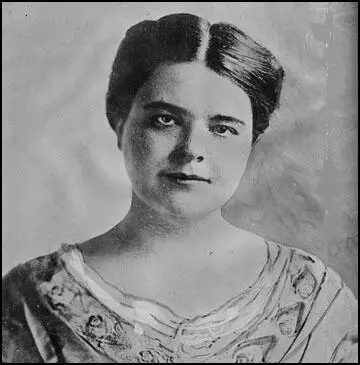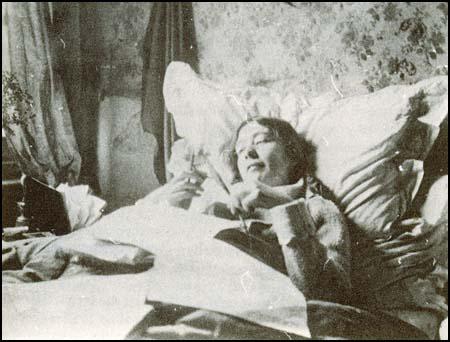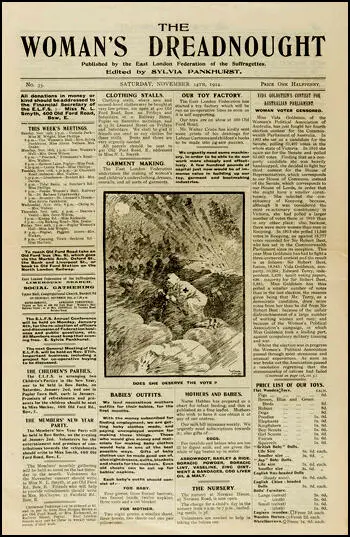Zelie Emerson

Zelie Passavant Emerson, the daughter of Hubbard Rufus Emerson and Zelie Passavant Emerson, was born in Holyoke, Hampden County, Massachusetts on 15th December, 1883. (1)
Her mother was an intimate of Andrew Carnegie who came close to marriage. She persuaded him to finance the building of the Michigan Carnegie Libraries. Zelie's father was a successful industrialist who made a fortune from wood pulp. He died when she was only thirteen years old, leaving her an income of $10,000 a year. (2)
In 1903 Zelie Emerson began studying literature at the University of Michigan. She became involved in politics and moved to Chicago living initially at the Northwestern University Settlement, that had been influenced by the Hull House Settlement established by Jane Addams. During this period she took menial jobs so that she could study working conditions. (3)
Zelie Emerson: Trade Unionist
Emerson became a member of the Chicago Women's Trade Union League and helped to organise the garment workers' strike in September 1910 and involved 100,000 strikers. Emerson, dubbed by the press as the "scrubwoman heiress", was director of relief work, chair of the Rent Committee and ran the restaurant on Noble Street established to feed strikers and their families. (4)
In January 1911 Sylvia Pankhurst arrived in America in an effort to raise funds for the women's suffrage movement. She had meetings with several political activists including Charlotte Perkins Gilman, Anna Howard Shaw, Lillian Wald and Jane Addams. Pankhurst addressed 1,000 people at the Ford Hall in Boston. This was followed by a torchlight procession: "Miss Sylvia Pankhurst walked in the procession among a group of Boston Suffragists. With banners flying and drum and fife corps playing, the picturesque spectacle attracted large crowds." (5)
Sylvia Pankhurst also met Zelie Emerson and Stella Miles Franklin. The three women held strong socialist beliefs and shared a concern in the plight of working-class women. Emerson and Franklin agreed "to cross the Atlantic to join her breakaway socialist-suffragette movement and work on her projects in the East End". (6)
East London Federation of Suffragettes
On her return home Sylvia Pankhurst began immediately the work that led to the establishment of East London Federation of Suffragettes. She later recalled: "I determined that on my return home I would give all my time as a voluntary worker in the active movement, doing whatever I saw required to be done which would not be attempted without my intervention. What I had earned in America would maintain me for some time. I would add to it by writing occasional articles." (7)
Norah Smyth supplied most of the money for this venture. Her father died in 1911 and left her a personal fortune of around £20,000. (8) Zelie Emerson, who arrived in May, 1912, also helped her fund this project. (9) Zelie and Sylvia found an old baker's shop opposite St Mary's church, and 198 Bow Road became the campaign headquarters. Sylvia painted the board over the shop front with the words "Votes for Women" in gold leaf. (10)
Zelie Emerson was willing to work hard in order it became a success: "Zelie Emerson had scurried back to us from the United States, eager to be in the thick of it... Presently she was ladling out soup in Tryphena Place, Bow Common Lane, an unsavoury neighbourhood, her black eyes frowning intent, and her red lips pursed - her little plump figure hurrying, scurring." (11)

Other members of the East London Federation of Suffragettes included Keir Hardie, Norah Smyth, Julia Scurr, Mary Phillips, Millie Lansbury, Eveline Haverfield, Lilian Dove-Wilcox, Maud Joachim, Nellie Cressall and George Lansbury. It was an organisation that combined socialism with a demand for women's suffrage it worked closely with the Independent Labour Party. (12)
Zelie Emerson argued that in the East End of London most of the men did not have the vote: "Audiences were quick to grasp the absolute necessity of the vote to the unenfranchised worker, not only for the sake of the women themselves, but for the sake of the men also." (13)
For the next two years, Sylvia and Zelie lived, worked, travelled and went to prison together. (14) On 14th February 1913, the two women were arrested from throwing a stone at the window of the police station in Bow. They were arrested and sentenced to six weeks in prison. After going on hunger strike they were released. On 17th February, they broke windows of a branch of Westminster Bank in Bow Road. (15) This was followed by damaging the greens of Bradford Moor golf course. The magistrate said that if the women behaved as "common riffraff" then they must be treated as such and they were both sentenced to two months' hard labour. (16)
Zelie and Sylvia served their sentence in Brixton Prison. They went on hunger and thirst strike and were placed in the hospital wing and force-fed. Sylvia was released after five weeks. During her time in prison she had been force-fed for a month. Zelie was kept in prison for seven weeks although she had appendicitis. (17)
Sylvia was allowed to visit Zelie: "She was ill and asking for me. They hoped that I might quiet her. I knew by the dry, burning touch of her skin that she had fever. She complained of terrible abdominal pain. Shocked at her condition, I took her in my arms, uttering foolish words: 'Oh, my little sweetheart! Oh, my little sweetheart!' Her wrist was bandaged. She told me she had tried to commit suicide by cutting an artery. She had dug into the flesh with her small, blunt penknife, till she reached the artery, but when she had tried to cut it, she found it, she said, too tough, and like an India-rubber band. They had come to the cell while she was working at it." (18)

On 5th November 1913, Zelie Emerson presided over the meeting where Captain Sir Francis Vane, a Boer War veteran, agreed to form a volunteer corps, for the projection of militant suffragettes and labour unionists. "The Boer veteran explained that he proposed to establish a labour training corps. Waving aloft a huge knotted club, Sir Francis said he was prepared to use that weapon wherever he saw women injured and in labour disputes, or wherever the oppressed needed aid." (19)
However, after leaving the meeting Emerson was badly beaten by police carrying clubs. Suffering from a fractured skull, she was carried away by sympathisers. (20) Five days later, The New York Times reported: "Zelie Emerson, the well-known suffragette of Jackson, Michigan, is lying seriously ill from concussion of the brain, the result of injuries suffered in the riot at Bow Baths, in the East End of London.. When the police tried to arrest her a violent fight with sticks of and clubs took place, in the course of which Miss Emerson was knocked down with a blow to the head." (21)
Zelie Emerson recovered and the following month she was back in court charged with assaulting and obstructing the police. Emerson admitted to carrying a rope dipped in tar and weighted with lead, to defend herself against the police. One newspaper reported: "Miss Emerson when called to the witness stand testified that the statement of the policeman that she had deliberately struck him and smashed his helmet was untrue, although, she said, she might have done so accidentally." The magistrate believed her account and the case against her was dismissed. (22)
The police were particularly brutal to the East End suffragettes. They attacked a meeting in January 1914 while Sylvia Pankhurst was speaking. Zelie was badly beaten, Mary Leigh was knocked unconscious and they broke the arms of two other women. At her trial Zelie admitted in court that: "I always go to meetings armed... for over two years I have been closely associated with the People's Army." (23)
On 26th February 1914, the case of Zelie Emerson was raised in the House of Commons and Reginald McKenna, the Home Secretary, was asked if he was going to "expel her from the country as an undesirable alien". McKenna replied: ""If Miss Emerson again commits an offence bringing her within the provisions of the Aliens Act the question of applying to the court for a recommendation for her expulsion will be considered." (24)
June Hannam has pointed out: "The East London Federation of Suffragettes (ELF) was successful in gaining support from working women and also from dock workers. The ELF organized suffrage demonstrations and its members carried out acts of militancy. Between February 1913 and August 1914 Sylvia was arrested eight times. After the passing of the Prisoners' Temporary Discharge for Ill Health Act of 1913 (known as the Cat and Mouse Act) she was frequently released for short periods to recuperate from hunger striking and was carried on a stretcher by supporters in the East End so that she could attend meetings and processions. When the police came to re-arrest her this usually led to fights with members of the community which encouraged Sylvia to organize a people's army to defend suffragettes and dock workers. She also drew on East End traditions by calling for rent strikes to support the demand for the vote." (25)
The Women's Dreadnought
In January 1914 Zelie Emerson suggested that the East London Federation of Suffragettes needed its own newspaper. She argued that the Women's Social and Political Union newspaper, The Suffragette, gave little concern to the concerns and cares of working women, and that there was a gap in the market. At a large meeting of ELF members, they chose the name, The Woman's Dreadnought. They agreed that the paper would be sold for a halfpenny for the first four days; any leftover copies would then be distributed for free. (26)
Norah Smyth supplied most of the money for this venture. Zelie Emerson got the project off the ground by consulting printers, producing dummy sheets, deciding the size and format and securing a small amount of advertising. Zelie managed to persuade Lipton's Cocoa and Neave's Food took out three-months trial contracts. Rachel Holmes has argued that "working-class East End suffragettes and socialists were seen as an interesting potential market." (27)

The Woman's Dreadnought first appeared on 8th March 1914. "The name of our paper, The Woman's Dreadnought, is symbolic of the fact that the women who are fighting for freedom must fear nothing... the chief duty of Woman's Dreadnought will be to deal with the franchise question from the working woman's point of view, and to report the activities of the votes for women movement in East London." (28)
Although they printed 20,000 copies of the first edition, by the third issue total sales were only listed as just over 100 copies. During processions and demonstrations, the newspaper was freely distributed as propaganda for the EFF and the wider movement for women's suffrage. (29)
Later Life
In May 1914 Emerson returned to America and in 1916 moved to Florida with her mother. They purchased a large farm in Lakeland of more of fifty acres of citrus groves. (30) The business was a success and they also bought citrus groves in California. (31)
After the death of her mother Zelie Emerson established a partnership with Bessie Bruce. In June 1958 they came into conflict with the local authorities: "Seeking to force the country commission to change its road-building plans in the Lakeland Highlands, two women citrus growers today brought suit for injunction against the country and the State Road Department. Zelie P. Emerson and Bessie Bruce charged that drainage plans for State Road 540, westward from Highland City, would collect all rainfall from the slope of a nearby hill and deposit the water in "one of the lower portions" of their grove. They charged this would create 'a stagnant, nauseous and unhealthy condition, thereby breeding mosquitoes and in other ways jeopardizing the health of the petitioners, who live adjacent to said road'." (32)
Zelie Emerson died in March, 1969.
Primary Sources
(1) The New York Times (19 February 1913)
Sylvia Pankhurst was today sentenced to two months' hard labour for window breaking. The magistrates said that if she behaved as a "common riffraff" she must be treated as such.
A similar sentence was passed on the American suffragette, Zelie Emerson.
Suffragettes last night visited the Bradford Moor golf course and damaged several greens.
Underwriters at Lloyd's are now quoting a rate to cover the risk of damage to golf greens by suffragettes. The premium is equivalent to 2 per cent. The rate quoted on each green is $5 for twelve months, the underwriters undertaking to pay for the damage to each green up to $250. All eighteen holes, however, must be insured as, but for this provision, clubs would be disposed to insure only the greens most easily accessible to raids.
(2) Hamilton Daily News (6 November 1913)
By a clever stratagem, which completely hoodwinked the large force of police sent to prevent her from speaking, Miss Sylvia Pankhurst was enabled to announce at the Bow Baths, in the east end of London, tonight the formation of a volunteer corps, organised under command of Captain Sir Francis Vane, a Boer War veteran, for the projection of militant suffragettes and labour unionists.
Miss Zelie Emerson presided over the meeting. Just as the meeting was called to order the statement was made that the residence of George Lansbury, former Socialist member of Parliament and a warm supporter of the militant suffragettes, was surrounded by police. The crowd rushed from the Baths and found a large number of foot and mounted police around Lansbury's house with a taxicab in front of the entrance. Mr Lansbury arrived on the scene and was uproariously greeted as he entered his home. The report was spread that the preparations portended the arrest of Sylvia Pankhurst.
The lights of the house were extinguished, and suddenly a woman rushed from the doorway and sprang into the taxi, which surrounded by mounted police, proceeded to Bethnal Green. Then Miss Daisy Lansbury, daughter of the ex-Socialist member, stepped out, much to his discomfiture of the police.
Meanwhile Miss Pankhurst entered the Baths practically unobserved. The only disorder was caused by an attack by the women and a few reporters, whom they suspected of being detectives Mr Lansbury and Sir Frances Vane followed Miss Pankhurst to the platform. The Boer veteran explained that he proposed to establish a labour training corps. Waving aloft a huge knotted club, Sir Francis said he was prepared to use that weapon wherever he saw women injured and in labour disputes, or wherever the oppressed needed aid.
The general staff of the organization will be drawn from officers who have seen war, and both men and women are eligible for the ranks…
When Miss Pankhurst left the meeting she was surrounded by a bodyguard of east enders, and made her escape after a lively battle with the police, who were compelled to draw their clubs. The crowd retaliated with sticks, and the result was that several of the belligerents were injured, among them Miss Emerson, who was knocked down and bruised about the head. She, too, escaped arrest, being carried away by sympathisers.
(3) San Francisco Call (6 November 1913)
Miss Zelie Emerson, the American suffragette. Is under the care of a member of the home office medical staff today as a result of a beating which she received at the hands of the police last night during a riot at Bow Baths in the east end. Miss Emerson led a squad of militants against the police, who were trying to arrest Sylvia Pankhurst and in the fighting which followed many were bruised. Miss Zelie Emerson, whose home is in Jackson. Michigan, has just recovered from injuries sustained in a struggle with the police last month, when an attempt was made to arrest Sylvia Pankhurst while she was addressing an audience in the east end of London.
Miss Emerson was present at the meeting and in the excitement she was swept from her feet and painfully injured. She was arrested several months ago for her part in the suffrage fight and her imprisonment caused a furore.
(4) The New York Times (11 November 1913)
Zelie Emerson, the well-known suffragette of Jackson, Michigan, is lying seriously ill from concussion of the brain, the result of injuries suffered in the riot at Bow Baths, in the East End of London, on November 6, according to an announcement made today by Mrs Dacre Fox at the regular weekly meeting of the Women's Social and Political Union.
Miss Emerson presided on November 5 at a meeting, at which it was announced that a volunteer corps was to be organised for the protection of the militant suffragettes. Sylvia Pankhurst was present, and when the police tried to arrest her a violent fight with sticks of and clubs took place, in the course of which Miss Emerson was knocked down with a blow to the head.
(5) New York Times (24 December, 1913)
A police magistrate today dismissed the charges of assaulting and obstructing the police brought against Zelie Emerson, the militant suffragette of Jackson, Michigan, in connection with a disturbance on December 15 in the Bow District of the East End of London. The American woman was thereupon liberated and walked out of court accompanied by her friends with all the honours of war.
Miss Emerson when called to the witness stand testified that the statement of the policeman that she had deliberately struck him and smashed his helmet was untrue, although, she said, she might have done so accidentally.
(6) New York Times (9 March 1914)
Among those taken into custody in the suffragette disturbance in Trafalgar Square to-day was Miss Zelie Emerson of Jackson, Michigan Miss Emerson has been arrested several times for participation in suffragette demonstrations, and recently there were rumors in circulation that steps were being taken by the British Government to expel her from the country as an undesirable alien.
Replying on February 26 to a question put in the House of Commons as to whether this report was true, Reginald McKenna, the Home Secretary, said that no such steps were being taken. He added: "If Miss Emerson again commits an offence bringing her within the provisions of the Aliens Act the question of applying to the court for a recommendation for her expulsion will be considered.
(7) The Miami News (22 September 1916)
An article in the Lakeland Telegram which will receive widespread notice concerns the coming to Lakeland of Miss Zelie Emerson and her mother, Mrs Z. P. Emerson, both noted suffragists. The two will make their home in Lakeland.
Miss Emerson's experiences in London created world-wide attention when she and Sylvia Pankhurst headed the great suffrage movement in that city just prior to the outbreak of the war.
Miss Emerson is one of the busiest property owners here, and she and her daughter, Miss Zelie, have their hands full with the management of the large farm and stock, and her fifty or more acres in the citrus groves.
(8) The Hope Star (15 August 1931)
The only American women who took part in the window-breaking and house burning campaign of the Parkhursts for women suffrage in England is now devoting her crusading energies to grapefruit orchards.
She is Miss Zelie Emerson. For one and a half years she was prominently identified with the Pankhursts. She was once imprisoned in London and released when she went on hunger strike.
She is now managing her large citrus groves in Florida and California and taking part in the work of the Business and Professional Women's Club in Lakeland.
(9) The Tampa Tribune (21 June 1958)
Seeking to force the country commission to change its road-building plans in the Lakeland Highlands, two women citrus growers today brought suit for injunction against the country and the State Road Department.
Zelie P. Emerson and Bessie Bruce charged that drainage plans for State Road 540, westward from Highland City, would collect all rainfall from the slope of a nearby hill and deposit the water in "one of the lower portions" of their grove.
They charged this would create "a stagnant, nauseous and unhealthy condition, thereby breeding mosquitoes and in other ways jeopardizing the health of the petitioners, who live adjacent to said road."

